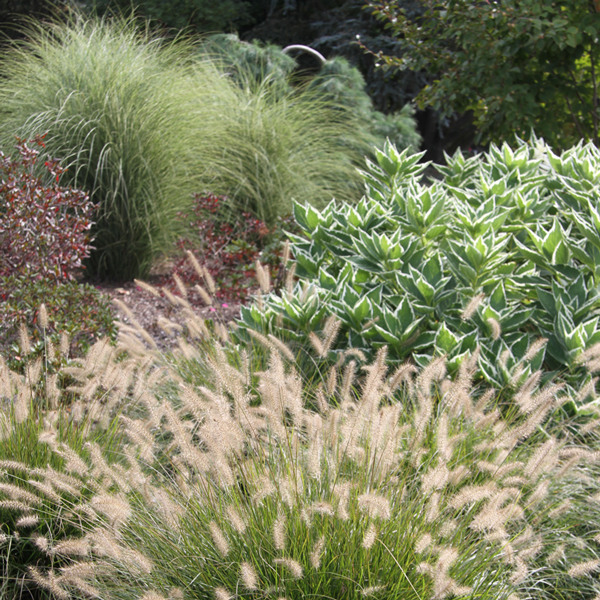
By R. Wayne Mezitt
Every April, just as the garden is awakening, it’s time to pay attention to the ornamental grasses before they begin their imminent new growth. Ornamental grasses are exceptional year-round garden features – they offer an ever-changing range of effects in the garden. And to ensure they look their best all spring and summer, last year’s dry foliage and stem stalks should be cut back before new shoots appear in late April or early May.
In my garden our ornamental grass clumps grow larger each year, so cutting back their stalks has become increasingly tedious, and their clean-up time consuming. Those with thicker, heavier stems like Miscanthus, Pennisetum and Panicum, are the most challenging. So we’ve devised a method that requires a lot less work, shortens the time and simplifies the cleanup.
Here’s the process we use:
1. Wrapping your arms around as large a group of stalks as you can, bunch them tightly together;
2. Loop a 2-3 ft. length of biodegradable rope or twine around the bundled tops and tie tightly about halfway up the stalks – a second person helping will make this easier. Larger clumps may require more than one bundle;
3. Cut the bottoms of each bundled stalk to a height of 3 to 12 inches, depending upon the type of grass and your preference. This can be accomplished with hand shears (very tedious!), hedge shears (electric or gas-powered types require much less effort then hand-operated ones), or even a brush cutter (my favorite!);
4. Using a pitchfork or your arms, load each cut bundle on a cart or vehicle, rake together any loose leaves, and haul all the refuse away to your compost pile;
5. Scratch around the now-shortened stem stubs and pull out any dead sections, paying particular attention to the center area of larger clumps. Adding fresh soil to the gaps can also help, allowing vigorous new shoots to fill-in;
6. Most ornamental grasses have deep root systems and require minimal fertilizing to keep them healthy. But if they are growing in poor or sandy soils, now is a good time to side-dress. Mix-in compost or a handful of a general fertilizer (like 8-8-8 with a high organic content) to the top few inches of soil around the clump;
7. Right now is also a perfect time to divide ornamental grass clumps, either to make them a more manageable size or to chunk-out new plants for planting in another area. Dig straight down using a spade – grasses have extensive root systems.
Some gardeners prefer cutting back grasses before winter, and this is also OK – most grasses will be sufficiently dormant to tolerate the process anytime after several hard freezes in November or December. But when you prune them in the fall you’re sacrificing the unique appearance of their graceful, tawny stalks, which can add a lot of appeal to an otherwise bland winter garden, especially when touched with frost and snow.
Don’t be alarmed if spring gets ahead of you and new growth starts to appear before your old stalks are cut back. New stems growing through last year’s stalks will still be healthy. But it will take time for new shoots to cover-up the old stalks, and the overall appearance can be less attractive early in the year. Selectively removing old stalks from among the new shoots is extremely tedious. If ornamental grasses are left unmaintained for several years they expand mostly on their outside edges. This can leave open voids in the middle of their clumps.
Using the cut-back technique described above simplifies the whole maintenance process. I always look forward to this early spring ritual — for me it marks the beginning of the growing season and another exciting year in my garden.
Wayne Mezitt is a 3rd generation nurseryman, a Massachusetts Certified Horticulturist, now chairman of Weston Nurseries of Hopkinton, Chelmsford & Hingham MA, and owner of “Hort-Sense”, a horticultural advisory business. He currently serves in various capacities on several horticulturally-related organizations, including the Massachusetts Horticultural Society at The Gardens at Elm Bank in Wellesley MA, and chairman for the Massachusetts Invasive Plant Advisory Group (MIPAG).









